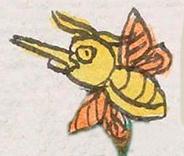pipiyolin (Mdz16r)
This element for the mountain honey bee (pipiyolin) has been carved from the compound sign for the place name, Pipiyoltepec. It shows the insect in a 3/4 view, facing toward the viewer's left. Its wings are spread and orange, and its body and head are yellow. It has two curving antennae and three stripes running across its back. It has a long snout.
Stephanie Wood
c. 1541, but by 1553 at the latest
Stephanie Wood
bees, wasps, hornets, vispas, abejas, avispón

pipiyol(in), honey bee, https://nahuatl.wired-humanities.org/content/pipiyolin
Abeja Melífera de Montaña
Stephanie Wood
Codex Mendoza, folio 16 recto, https://digital.bodleian.ox.ac.uk/objects/2fea788e-2aa2-4f08-b6d9-648c00..., image 42 of 188.
The Bodleian Libraries, University of Oxford, hold the original manuscript, the MS. Arch. Selden. A. 1. This image is published here under the UK Creative Commons, “Attribution-NonCommercial-ShareAlike 3.0 License” (CC-BY-NC-SA 3.0).


